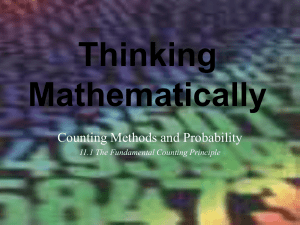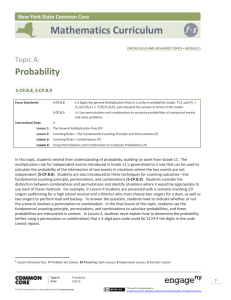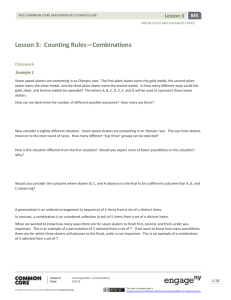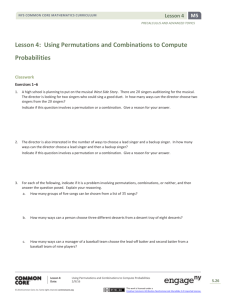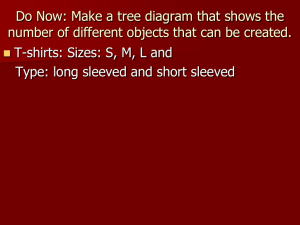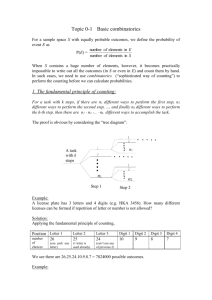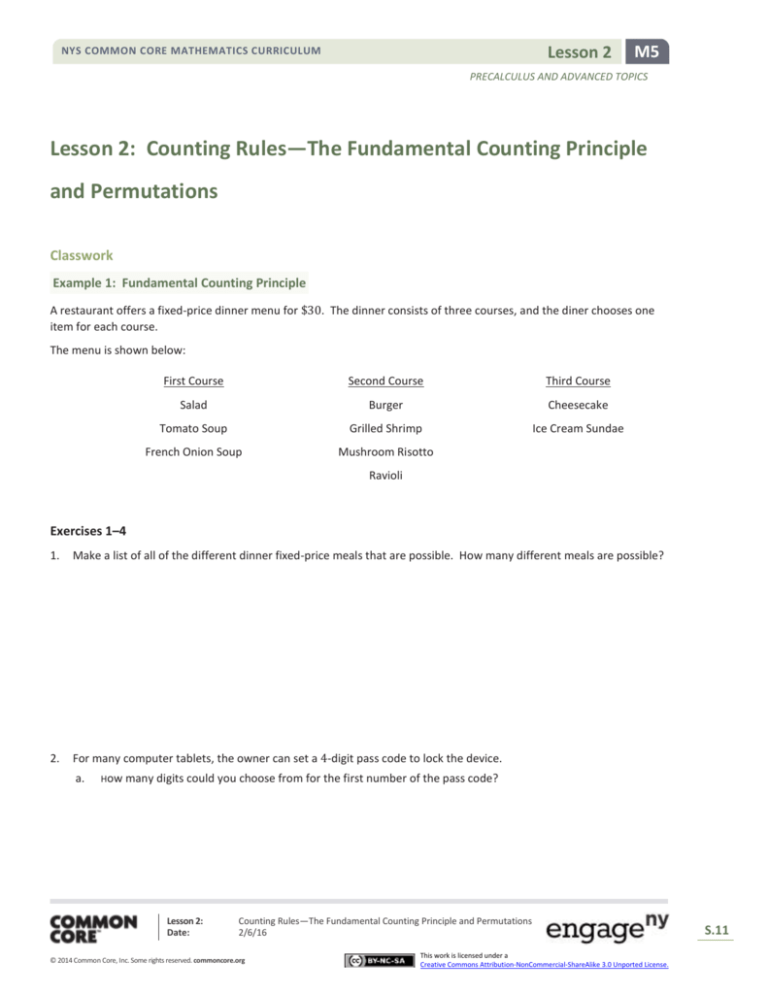
Lesson 2
NYS COMMON CORE MATHEMATICS CURRICULUM
M5
PRECALCULUS AND ADVANCED TOPICS
Lesson 2: Counting Rules—The Fundamental Counting Principle
and Permutations
Classwork
Example 1: Fundamental Counting Principle
A restaurant offers a fixed-price dinner menu for $30. The dinner consists of three courses, and the diner chooses one
item for each course.
The menu is shown below:
First Course
Second Course
Third Course
Salad
Burger
Cheesecake
Tomato Soup
Grilled Shrimp
Ice Cream Sundae
French Onion Soup
Mushroom Risotto
Ravioli
Exercises 1–4
1.
Make a list of all of the different dinner fixed-price meals that are possible. How many different meals are possible?
2.
For many computer tablets, the owner can set a 4-digit pass code to lock the device.
a.
How many digits could you choose from for the first number of the pass code?
Lesson 2:
Date:
Counting Rules—The Fundamental Counting Principle and Permutations
2/6/16
© 2014 Common Core, Inc. Some rights reserved. commoncore.org
This work is licensed under a
Creative Commons Attribution-NonCommercial-ShareAlike 3.0 Unported License.
S.11
Lesson 2
NYS COMMON CORE MATHEMATICS CURRICULUM
M5
PRECALCULUS AND ADVANCED TOPICS
b.
How many digits could you choose from for the second number of the pass code? Assume that the numbers
can be repeated.
c.
How many different 4-digit pass codes are possible? Explain how you got your answer.
d.
How long (in hours) would it take someone to try every possible code if it takes three seconds to enter each
possible code?
3.
The store at your school wants to stock sweatshirts that come in four sizes (small, medium, large, xlarge) and in two
colors (red and white). How many different types of sweatshirts will the store have to stock?
4.
The call letters for all radio stations in the United States start with either a 𝑊 (east of the Mississippi river) or a 𝐾
(west of the Mississippi River) followed by three other letters that can be repeated. How many different call letters
are possible?
Lesson 2:
Date:
Counting Rules—The Fundamental Counting Principle and Permutations
2/6/16
© 2014 Common Core, Inc. Some rights reserved. commoncore.org
This work is licensed under a
Creative Commons Attribution-NonCommercial-ShareAlike 3.0 Unported License.
S.12
Lesson 2
NYS COMMON CORE MATHEMATICS CURRICULUM
M5
PRECALCULUS AND ADVANCED TOPICS
Example 2: Permutations
Suppose that the 4-digit pass code a computer tablet owner uses to lock the device cannot have any digits that repeat.
For example, 1234 is a valid pass code. However, 1123 is not a valid pass code since the digit “1” is repeated.
An arrangement of four digits with no repeats is an example of a permutation. A permutation is an arrangement in a
certain order (a sequence).
How many different 4-digit pass codes are possible if digits cannot be repeated?
1st digit
2nd digit
3rd digit
4th digit
Exercises 5–9
5.
Suppose a password requires three distinct letters. Find the number of permutations for the three letters in the
code, if the letters may not be repeated.
6.
The high school track has 8 lanes. In the 100 meter dash, there is a runner in each lane. Find the number of ways
that 3 out of the 8 runners can finish first, second, and third.
7.
There are 12 singers auditioning for the school musical. In how many ways can the director choose first a lead
singer and then a stand-in for the lead singer?
8.
A home security system has a pad with 9 digits (1 to 9). Find the number of possible 5-digit pass codes:
a.
if digits can be repeated.
Lesson 2:
Date:
Counting Rules—The Fundamental Counting Principle and Permutations
2/6/16
© 2014 Common Core, Inc. Some rights reserved. commoncore.org
This work is licensed under a
Creative Commons Attribution-NonCommercial-ShareAlike 3.0 Unported License.
S.13
Lesson 2
NYS COMMON CORE MATHEMATICS CURRICULUM
M5
PRECALCULUS AND ADVANCED TOPICS
b.
9.
if digits cannot be repeated,
Based on the patterns observed in Exercises 5–8, describe a general formula that can be used to find the number of
permutations of 𝑛 things taken 𝑟 at a time or 𝑛𝑃𝑟 .
Example 3: Factorials and Permutations
You have purchased a new album with 12 music tracks and loaded it onto your MP3 player. You set the MP3 player to
play the 12 tracks in a random order (no repeats). How many different orders could the songs be played in?
This is the permutation of 12 things taken 12 at a time, or
12𝑃12 = 12 ∙ 11 ∙ 10 ∙ 9 ∙ 8 ∙ 7 ∙ 6 ∙ 5 ∙ 4 ∙ 3 ∙ 2 ∙ 1 = 479,001,600
The notation 12! is read 12 factorial and equals 12 ∙ 11 ∙ 10 ∙ 9 ∙ 8 ∙ 7 ∙ 6 ∙ 5 ∙ 4 ∙ 3 ∙ 2 ∙ 1.
Factorials and Permutations
The factorial of a non-negative integer 𝑛 is
𝑛! = 𝑛 ∙ (𝑛 − 1) ∙ (𝑛 − 2) ∙ (𝑛 − 3) ∙ … .∙ 1
Note: 0! is defined to equal 1.
The number of permutations can also be found using factorials. The number of permutations of 𝑛 things taken 𝑟 at a
time is
𝑛!
.
𝑛𝑃𝑟 =
(𝑛 − 𝑟)!
Exercises 10–15
10. If 9! is 362,880, find 10!.
Lesson 2:
Date:
Counting Rules—The Fundamental Counting Principle and Permutations
2/6/16
© 2014 Common Core, Inc. Some rights reserved. commoncore.org
This work is licensed under a
Creative Commons Attribution-NonCommercial-ShareAlike 3.0 Unported License.
S.14
Lesson 2
NYS COMMON CORE MATHEMATICS CURRICULUM
M5
PRECALCULUS AND ADVANCED TOPICS
11. How many different ways can the 16 numbered pool balls be placed in a line on the pool table?
12. Ms. Smith keeps eight different cookbooks on a shelf in one of her kitchen cabinets. How many ways can the eight
cookbooks be arranged on the shelf?
13. How many distinct 4-letter groupings can be made with the letters from the word champion if letters may not be
repeated?
14. There are 12 different rides at an amusement park. You buy five tickets that allow you to ride on five different
rides. In how many different orders can you ride the five rides in? How would your answer change if you could
repeat a ride?
15. In the summer Olympics, 12 divers advance to the finals of the 3-meter springboard diving event. How many
different ways can the divers finish 1st, 2nd, or 3rd?
Lesson 2:
Date:
Counting Rules—The Fundamental Counting Principle and Permutations
2/6/16
© 2014 Common Core, Inc. Some rights reserved. commoncore.org
This work is licensed under a
Creative Commons Attribution-NonCommercial-ShareAlike 3.0 Unported License.
S.15
Lesson 2
NYS COMMON CORE MATHEMATICS CURRICULUM
M5
PRECALCULUS AND ADVANCED TOPICS
Lesson Summary
Let 𝑛1 be the number of ways the first step or event can occur and 𝑛2 be the number of ways the second
step or event can occur. Continuing in this way, let 𝑛𝑘 be the number of ways the 𝑘th stage or event can
occur. Then based on fundamental counting principle, the total number of different ways the process can
occur is 𝑛1 ∙ 𝑛2 ∙ 𝑛3 ∙ … ∙ 𝑛𝑘 .
The factorial of a non-negative integer 𝑛 is
𝑛! = 𝑛 ∙ (𝑛 − 1) ∙ (𝑛 − 2) ∙ (𝑛 − 3) ∙ … .∙ 1.
Note: 0! is defined to equal 1.
The number of permutations of 𝑛 things taken 𝑟 at a time is
𝑛!
.
𝑛𝑃𝑟 =
(𝑛 − 𝑟)!
Problem Set
1.
For each of the following, show the substitution in the permutation formula and find the answer.
a.
4𝑃4
b.
10𝑃2
c.
5𝑃1
2.
A serial number for a TV begins with three letters, is followed by six numbers, and ends in one letter. How many
different serial numbers are possible? Assume the letters and numbers can be repeated.
3.
In a particular area code, how many phone numbers (###-####) are possible? The first digit cannot be a zero and
assume digits can be repeated.
4.
There are four NFL teams in the AFC east: Bills, Jets, Dolphins, and Patriots. How many different ways can two of
the teams finish first and second?
5.
How many ways can 3 of 10 students come in first, second, and third place in a spelling contest, if there are no ties?
6.
In how many ways can a president, a treasurer, and a secretary be chosen from among nine candidates if no person
can hold more than one position?
7.
How many different ways can a class of 22 second graders line up to go to lunch?
8.
Describe a situation that could be modeled by using 5𝑃2.
Lesson 2:
Date:
Counting Rules—The Fundamental Counting Principle and Permutations
2/6/16
© 2014 Common Core, Inc. Some rights reserved. commoncore.org
This work is licensed under a
Creative Commons Attribution-NonCommercial-ShareAlike 3.0 Unported License.
S.16
Lesson 2
NYS COMMON CORE MATHEMATICS CURRICULUM
M5
PRECALCULUS AND ADVANCED TOPICS
9.
To order books from an online site, the buyer must open an account. The buyer needs a username and a password.
a.
b.
c.
If the username needs to be eight letters, how many different usernames are possible:
i.
If letters can be repeated?
ii.
If the letters cannot be repeated?
If the password must be eight characters, which can be any of the 26 letters, 10 digits, and 12 special
keyboard characters, how many passwords are possible:
i.
If characters can be repeated?
ii.
If characters cannot be repeated?
How would your answers to part (b) change if the password is case-sensitive? (In other words, Password and
password are considered different because the letter p is in uppercase and lowercase.)
10. Create a scenario to explain why 3𝑃3 = 3!.
11. Explain why 𝑛𝑃𝑛 = 𝑛! for all positive integers 𝑛.
Lesson 2:
Date:
Counting Rules—The Fundamental Counting Principle and Permutations
2/6/16
© 2014 Common Core, Inc. Some rights reserved. commoncore.org
This work is licensed under a
Creative Commons Attribution-NonCommercial-ShareAlike 3.0 Unported License.
S.17

